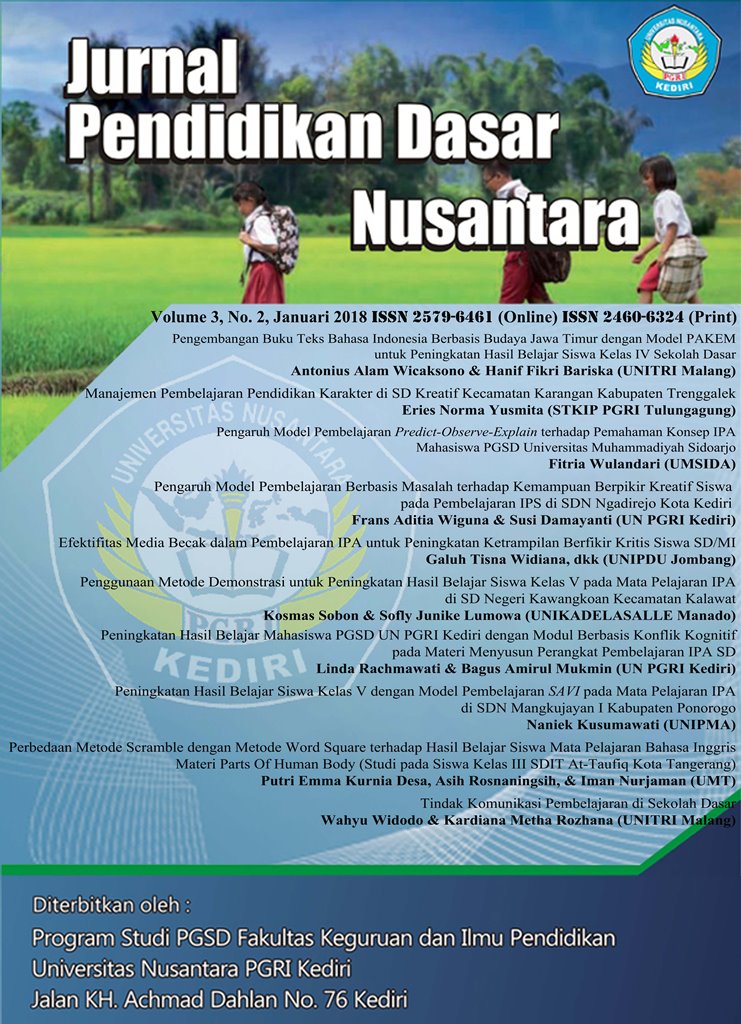PENGGUNAAN METODE DEMONSTRASI UNTUK PENINGKATAN HASIL BELAJAR SISWA KELAS V PADA MATA PELAJARAN IPA DI SD NEGERI KAWANGKOAN KECAMATAN KALAWAT
DOI:
https://doi.org/10.29407/jpdn.v3i2.11788Keywords:
demonstration methods, science, learning activity, learning resultAbstract
The purpose of this research is to increase student activity and learning outcomes in science learning in fifth grade. This research is a classroom action research conducted in two cycles. Each cycle consists of two learning meetings. The subject of this research is the fifth grader at the state elementary school of kawangkoan. Data collection techniques use tests, observations and documentation. The results showed that: (1) student learning activity in first cycle is 72,50% with active criterion and on second cycle is 76,15% with active criterion; (2) mastery of student learning outcomes in first cycle is 71,43% and second cycle is 100%. Based on these results, it can be concluded that by the method of demonstration can improve the quality of learning science subjects, that is: student activity and student learning outcomes of fifth grade state elementary school Kawangkoan.
Keywords: demonstration methods, science, learning activity, learning result
Downloads
References
Djahiri, (1993).Landasan falsafah dan teori teknologi pendidikan, Media Kencana, IKIP Jakarta
Ekawarna. 2013. Penelitian Tindakan Kelas, Edisi Revisi. Jakarta: Referensi GP Press Group.
Hamruni. 2012. Strategi Pembelajaran. Yogyakarta: Insan Madani.
Haryono. 2013. Pembelajaran IPA yang Menarik dan Mengasyikkan: Teori dan Aplikasi PAIKEM. Yogyakarta: Kepel Press.
Hamalik, Oemar. 2010. Proses Belajar Mengajar. Jakarta: Pustaka Setia
Kunandar. 2012. Langkah Mudah Penelitian Tindakan Kelas sebagai Pengembangan Profesi Guru. Jakarta: PT. Rajagrafindo Persada.
Subini, Nini, dkk. 2010. Psikologi Pembelajaran. Yogyakarta: Mentari Pustaka.
Susanto, Ahmad. 2013. Teori Belajar & Pembelajaran di Sekolah Dasar. Jakarta: Kencana Prenada Media Group.
Downloads
Published
Issue
Section
License
Authors who publish with this journal agree to the following terms:
- Copyright on any article is retained by the author(s).
- The author grants the journal, the right of first publication with the work simultaneously licensed under a Creative Commons Attribution License that allows others to share the work with an acknowledgment of the work’s authorship and initial publication in this journal.
- Authors are able to enter into separate, additional contractual arrangements for the non-exclusive distribution of the journal’s published version of the work (e.g., post it to an institutional repository or publish it in a book), with an acknowledgment of its initial publication in this journal.
- Authors are permitted and encouraged to post their work online (e.g., in institutional repositories or on their website) prior to and during the submission process, as it can lead to productive exchanges, as well as earlier and greater citation of published work.
- The article and any associated published material is distributed under the Creative Commons Attribution-ShareAlike 4.0 International License
































